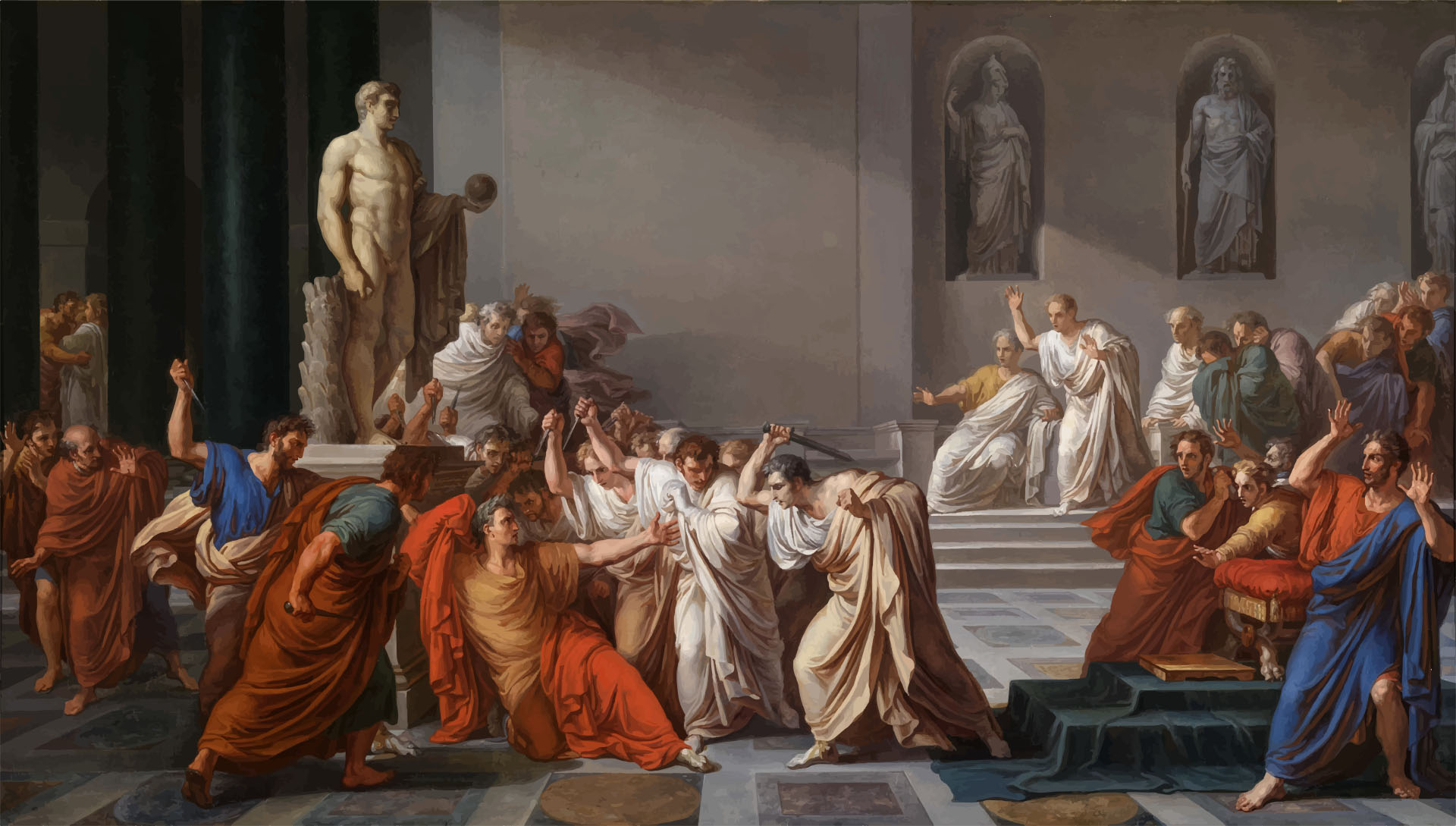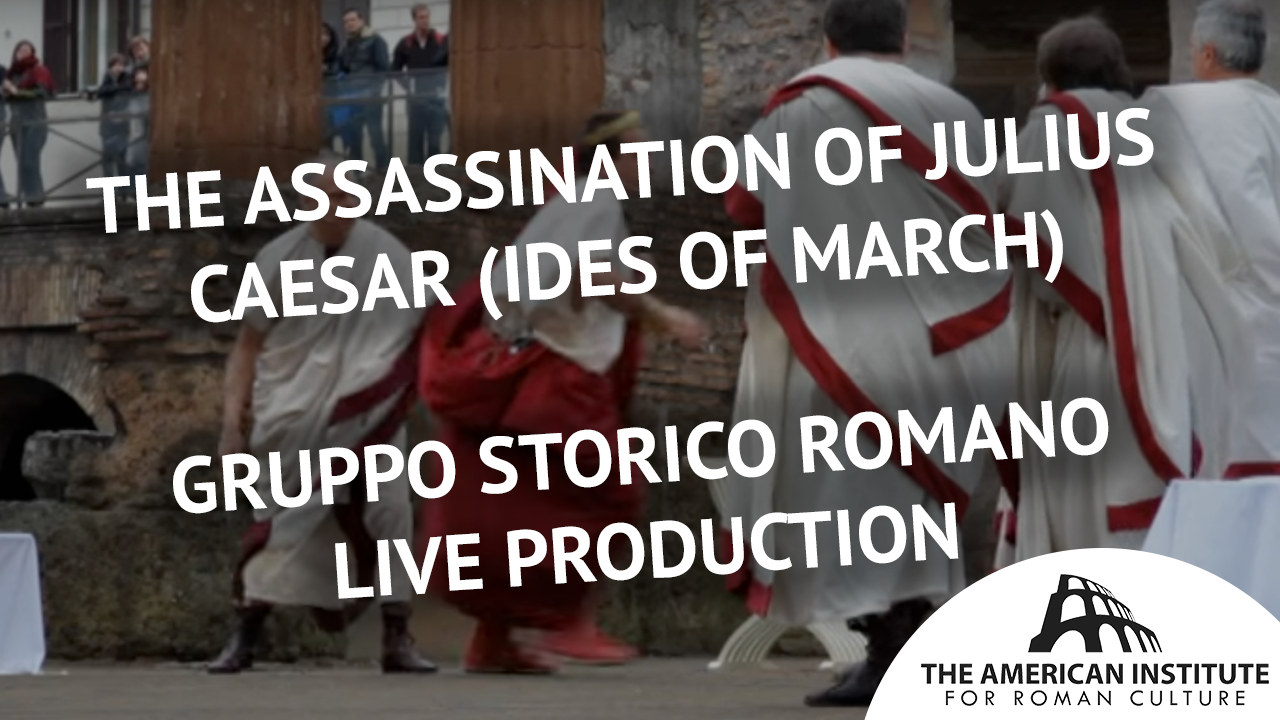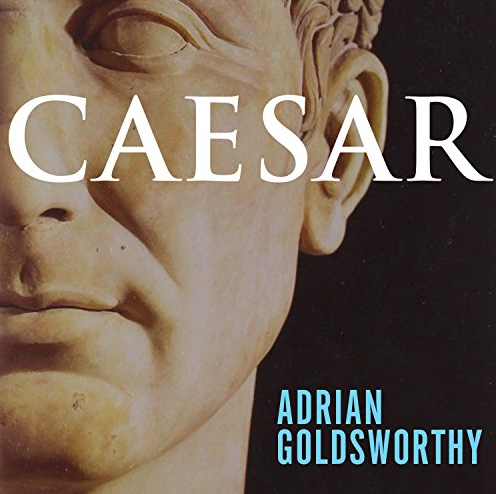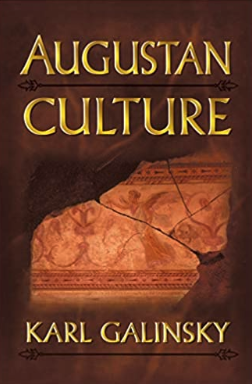The fifteenth of March, 44 BC- the date of the assassination of Julius Caesar– has gone down in history as one of the most consequential dates in Roman history. Why did the conspiracy form? Why was Julius Caesar killed on this particular day? Why was he killed in the Senate House located within the Theater of Pompey complex (and not the Senate House in the Forum or elsewhere)?
First, a brief historical overview. Caesar, a brilliant orator, formed a political alliance with Pompey and Crassus in 60 BCE. He won the consulship in 59, and served as proconsul governor of Gaul from 58-50. During that time, he aggressively fought and conquered much of Gaul, enrolling many of the Gauls into what became his own private army. Aside from amassing a loyal following in his province, far exceeding his mandate, he achieved great wealth, and when threatened with reprisals upon returning to Rome as a private citizen at the end of his term, he decided to challenge Rome, marching past a requisite boundary of the Rubicon River with his army on January 10, 49. After taking Rome, he then waged war against the government adherents and its defenders, winning many important battles throughout the Mediterranean. He celebrated four triumphs back in Rome, between September 21- October 2, 46. He continued to wage war through 45, celebrating a fifth triumph in October of 45.
Beware the Ides of March! Join me for a virtual walk through Rome today, retracing Julius Caesar’s final day, from his home in the Forum to the Senate House in the Campus Martius #IdesofMarch @ParcoColosseo @museiincomune @SaveRome #liveides pic.twitter.com/3rJWbYP2gy
— Darius Arya (@DariusAryaDigs) March 15, 2021
Read more:
Throughout his victories he set about pardoning his fellow Romans (his clemency “clementia” became legendary), returning to Rome to consolidate his power. Having declared himself dictator (an office held under extraordinary circumstances for short periods of time), he refused to step down from power, taking steps to consolidate his position. By January or February of 44, he declared himself perpetual dictator; he wasn’t going to step down. At that point, he began to assume more kingly regalia and assume an attitude that positioned himself above his fellow senators. His attitude was manifested, in particular, when Mark Antony tried to publicly to crown him during the Lupercalia festival in February and when he failed (or refused) to rise out of his chair on the rostra to greet senators, a sign of disrespect toward his peers.
The key ancient sources that were contemporary with the conspiracy and assassination are named but largely lost, serving as source material for later authors. Late Republican authors Asinius Pollio, Strabo, Oppius, Bibulus wrote various accounts with different perspectives, but survive only in reference by later authors. There is Cicero’s brief eyewitness account that survives in a letter, but it is Nicolaus of Damascus (born in 63 BC, friend of Herod the Great and one-time tutor of the children of Mark Antony and Cleopatra) who records the most vivid account within his narrative of the Life of Augustus, which he published after Augustus’ death. Other important sources preserved much later are Appian, Suetonius, and Plutarch, and Cassius Dio, who do reference the earlier sources.
So much of the assassination events depend on Rome’s singular topography and monuments. The conspiracy was hatched by a handful of senators, meeting in secret in their private homes to avoid suspicion. According to Nicolaus of Damascus (Life of Augustus, 23) they considered several scenarios for assassinating Caesar. First, along the Via Sacra (as Caesar lived in the forum, in the house of the pontifex maximus, known as the domus publica). Another was during voting in Campus Martius’ Saepta enclosure. Voting consisted of each voter first receiving a ballot, marking it, then walking individually across an erected bridge (pons), after which the voter would deposit his ballot in a basket. An honor guard of esteemed citizens oversaw the proceedings, so those roles could be filled by the conspirators. Another suggestion was to attack during a gladiator spectacle in the Theater of Pompey, as it would be easy to have enrolled gladiators as well as conspirators armed without arousing any suspicion. Finally, there was inside the Senate House, in which only Senators were allowed to enter, leaving Caesar alone and unguarded; in such setting the conspirators would hide knives underneath their togas.
The chosen day was feriae Iovi, sacred to Jupiter with a sacrifice on the Capitoline as well as the festival of Anna Perenna, whose stream and rural sanctuary was located along the Via Flaminia, well north of the city center, under modern day Piazza Euclide in the Parioli district of Rome. The festival was celebrated by making offerings at the sanctuary, and having a picnic and heavy drinking. (Ovid, Fasti, III.523-542). This meant that a lot of the population was elsewhere, and not in the center. Nicolaus of Damascus also cites gladiator spectacles ongoing in the Theater of Pompey on that day.
The exact number of the conspirators eludes us (25-80 according to the sources). Stab wounds on Caesar’s body gives some sense of the participants (23-35 according to the varying accounts). In all of the sources, key figures included Marcus Junius Brutus and Gaius Cassius Longinus as the original plotters. Decimus Junius Brutus Albinus was the man with the gladiators on hand. Lucius Tillius Cimber ended up initiating the moment of assassination in the Curia by grabbing Caesar’s toga on the pretext of discussing a false petition. The Casca brothers were both involved, Publius Servilius Casca striking the first blow, and Gaius Servilius Casca usually cited as striking the mortal blow.
The day was festive, as Romans headed to the suburban sanctuary, though voices continued to swirl with alleged plots and conspiracies. Julius Caesar had long since disbanded his bodyguard and arrived at the Curia Pompeiana from his house in the forum in a litter, accompanying by the lictors and retinue. The Curia in the forum was not an option, as it had been destroyed in earlier civil war riots. It was being rebuilt and unusable at the time. As Caesar entered the senate building, he was interrupted by Cimber, according to plan, and the assassination began. The scene was chaotic, with accounts giving blow by blow details, deflections, struggles, and accidental stabbings of co-conspirators. Plutarch even cites that Caesar used his stylus pen as a weapon to stab an assassin. In the end, Julius Caesar lay dead, at the foot of the statue of his former rival Pompey the Great. In the ensuing chaos, the assassins fled to the Capitoline Hill with supporters and gladiators, afraid of reprisals from Caesar’s soldiers and supporters in the city; the Capitoline was a small hill with few access points, an easy place to defend in the city. Caesar’s supporters regrouped and assessed the situation.
On March 17 a Senate meeting led to the exoneration of the assassins and confirmation of the laws previously passed by Caesar. As a result, the populace voiced its support for Caesar and his actions. On March 19th, Caesar’s will was read, and in it Caesar named his great nephew Octavian his son and heir. On March 20, Mark Antony took charge of the funeral and delivered an inspiring eulogy that rallied support among the populace for Caesar more than ever and led to the liberators’ leaving Rome for regrouping. Subsequent legislation was passed and Antony and Octavian formed with Lepidus the second triumvirate. The Civil War that followed began by waging war against the assassins and their supporters and ended only with the Battle of Actium in 31 BCE between Octavian and Antony, allied with Cleopatra. Octavian, later called Augustus in 27 BCE, would go on to found a dynasty and succeed where Caesar failed, forever changing Rome from a Republic into one of dynastic rule. What Caesar started as perpetual dictator was completed by Augustus as princeps over a fortuitous long life, dying in 14 CE. During his reign Augustus wisely came to focus on Caesar the god (divus Iulius), who received a temple (42-29 BCE) in the forum on the spot of his cremation and no longer Caesar the man.
There is an ample bibliography on Julius Caesar and the assassination. The definitive book on the assassination is Barry Strauss’ The Death of Caesar: The Story of History’s Most Famous Assassination.
For Julius Caesar, there are many biographies, including A. Goldsworthy, Caesar: Life of a Colossus.
For Augustus and his reign, a good selection includes the works of Karl Galinsky: Augustus: Introduction to the life of an emperor, Cambridge Companion to the Age of Augustus, and Augustan Culture.
Watch: Gruppo Storico Romano’s dramatic reconstruction of Caesar’s assassination live at Largo Argentina:
This content is brought to you by The American Institute for Roman Culture, a 501(C)3 US Non-Profit Organization.
Please support our mission to aid learning and understanding of ancient Rome through free-to-access content by donating today.
The Death of Caesar: The Story of History’s Most Famous Assassination
Caesar: Life of a Colossus
Augustus
The Cambridge Companion to the Age of Augustus (Cambridge Companions to the Ancient World)
Augustan Culture
Cite This Page
Cite this page as: Darius Arya, The American Institute for Roman Culture, “Assassination of Julius Caesar – Ides of March (March 15) – 44 BC” Ancient Rome Live. Last modified 03/15/2020. https://ancientromelive.org/assassination-of-julius-caesar-ides-of-march-15-44-bc/
License
Created by The American Institute of Roman Culture, published on 03/15/2020 under the following license: Creative Commons: Attribution-NonCommercial-ShareAlike. This license lets others remix, tweak, and build upon this content non-commercially, as long as they credit the author and license their new creations under the identical terms. Please note that content linked from this page may have different licensing terms.








